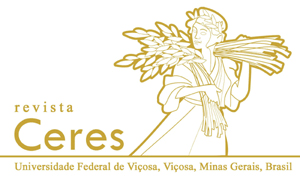Resumo em Português:
Objetivou-se, com este trabalho, avaliar mudas de pepino e de tomateiro em relação a diferentes composições de substratos orgânicos, formulados com composto de resíduos do abate de aves, podas de árvores e areia. Os experimentos foram realizados em bandejas com 200 células, em blocos casualizados. Para mudas de tomateiro, os tratamentos foram: T0 (Plantmax® HT); T1 (composto); T2 (composto + areia, proporção 3:1 peso); T3 (composto + areia, proporção 1:1 peso) e T4 (composto + areia, proporção 1:3 peso). Para mudas de pepino, os tratamentos foram: T0 (Plantmax® HA) e as mesmas composições de substratos orgânicos adotadas para as de tomate. Avaliaram-se a emergência de plântulas (EP), o comprimento de raiz (CR), a massa seca de raiz (MSR) e da parte aérea (MSPA). Os substratos T0 e T4, que proporcionaram emergência rápida das plântulas de tomateiro, propiciaram maior CR. Mas os valores de CR nesses subtratos não diferiram daqueles observados em T2 e T3, aos 20 dias após a emergência (DAE). Houve aumento da MSPA do tomateiro, cultivado em T4, em relação à dos cultivados em T0 e T3. A MSR do tomateiro, em T2, T3 e T4, foi superior à observada em T0 e T1. Para a MSPA do pepino, aos 30 DAE, houve acúmulo de massa seca das plantas cultivadas em T3 e T4, em relação à dos tratamentos T0 e T1. Em relação à MSR, os substratos à base de composto proporcionaram resultados superiores aos de T0, destacando-se T3 e T4. Assim, para produção de mudas de pepino, recomendam-se os substratos T3 e T4 e, para tomateiro, o substrato T4.
Resumo em Inglês:
The aim of this study was to evaluate the response of tomato and cucumber seedlings to different compositions of organic substrates formulated with compost of poultry slaughterhouse wastes, tree pruning residue, and sand. Experiments were performed in 200-cell trays in a randomized block design. The treatments for tomato seedlings were: T0 (Plantmax® HT); T1 (compost); T2 (compost + sand, proportion 3:1 weight); T3 (compost + sand, proportion 1:1 weight) e T4 (compost + sand, proportion 1:3 weight); and for cucumber seedlings were: T0 (Plantmax® HA) and the same composition of organic substrates used for tomato seedlings. Seedling emergence (EP), root length (CR), dry mass of the root (MSR), and shoot (MSPA) were evaluated. Substrates T0 and T4 provided a faster EP for tomato seedlings, thus increasing the CR. However, values of CR in these substrates did not differ from those in T2 and T3 on the 20th day after seedling emergence (DAE). There was increase in the MSPA of tomato seedlings from T4 comparing with those from T0 and T3. The MSR of the tomato seedlings from T2, T3 and T4 were higher than those from T0 e T1.The MSPA of cucumber of plants from T3 and T4 showed a higher accumulation of dry mass comparing with those from T0 e T1. The, treatments with compost had MSR higher than T0, especially T3 e T4. Therefore, the substrates T3 and T4 are recommended for cucumber seedlings and T4 for tomato seedlings.
